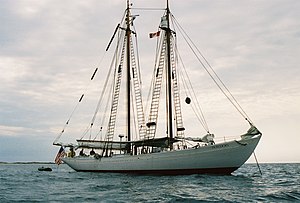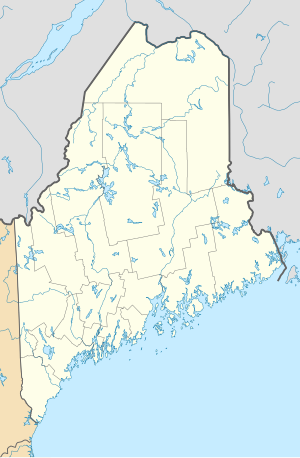Bowdoin (Arctic schooner)

Bowdoin at anchor off Sable Island, Nova Scotia
|
|
| History | |
|---|---|
| Owner: |
|
| Builder: |
|
| Launched: | 1921 |
| Commissioned: | 16 June 1941 as IX-50 |
| Decommissioned: | 16 December 1943 |
| Struck: | 14 May 1944 |
| General characteristics | |
| Tonnage: | 66 GRT |
| Length: |
|
| Beam: | 21 ft (6.4 m) |
| Draft: | 10 ft (3.0 m) |
| Sail plan: | Gaff-rigged Schooner |
|
Bowdoin (Arctic Exploration Schooner)
|
|
| Location | Castine, Maine |
| Coordinates | 44°23′12″N 68°47′48″W / 44.38667°N 68.79667°WCoordinates: 44°23′12″N 68°47′48″W / 44.38667°N 68.79667°W |
| Built | 1921 |
| Architect | Hodgdon Brothers; William H. Hand ,Jr. |
| NRHP Reference # | 80000411 |
| Significant dates | |
| Added to NRHP | 12 February 1980 |
| Designated NHL | 20 December 1989 |
The schooner Bowdoin /ˈboʊdᵻn/ was designed by William H. Hand, Jr., and built in 1921, in East Boothbay, Maine, at the Hodgdon Brothers Shipyard now known as Hodgdon Yachts. She is the only American schooner built specifically for Arctic exploration, and was designed under the direction of explorer Donald B. MacMillan. She has made 29 trips above the Arctic Circle in her life, three since she was acquired by the Maine Maritime Academy in 1988. She is currently owned by the Maine Maritime Academy, located in Castine, Maine, and is used for their sail training curriculum.
The schooner's design and construction were carefully considered and well-executed, although neither was radical for their day. The vessel is unique today because of her specialized purpose—she is heavy and carries less sail for her displacement than most schooners because, in addition to the obvious ice hazards, the Arctic is known for having either no wind at all or too much..
Bowdoin first crossed the Arctic Circle on 23 August 1921. A place unknown to most of the world, the Arctic had had few visitors. Only sixteen years before, the goal of many generations of Arctic explorers had been reached when a northwest passage was traversed — a route which was, practically speaking, unusable, and after the construction of the Panama Canal, no longer necessary. Peary's North Pole expedition was merely a dozen years past. The last few Hudson's Bay and Davis Strait whalers had made their final trip home two years before.
Bowdoin sailed north with Macmillan two dozen times, carrying scientists, adventurers, and students.
...
Wikipedia


